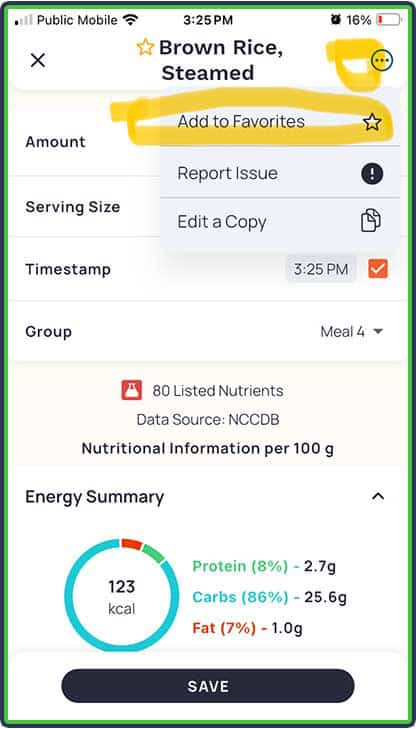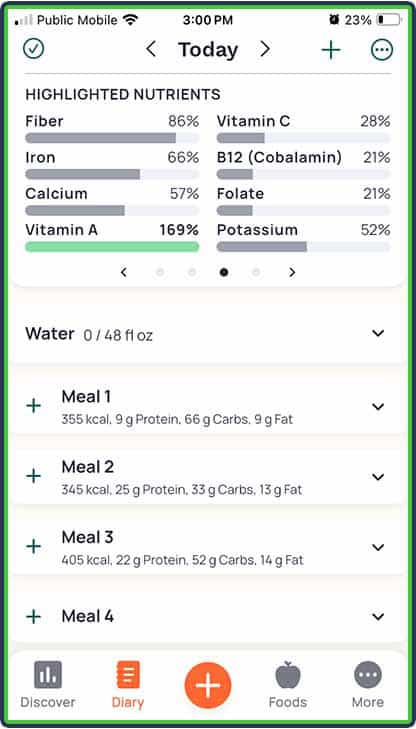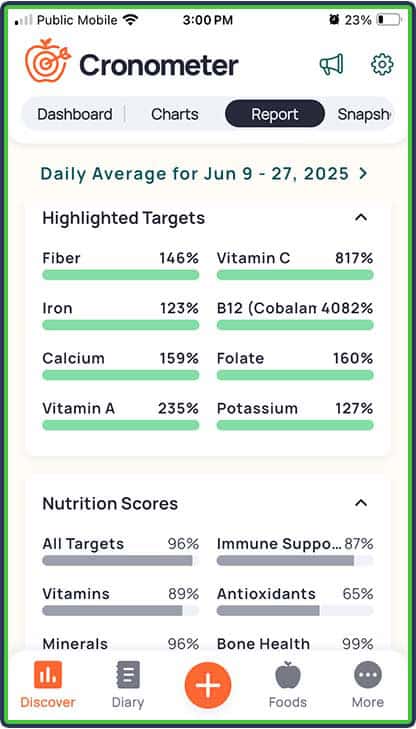Some links in this article are affiliate links, which means we earn from qualifying purchases. Learn more.
Cronometer is my personal favourite nutrition tracking app for ANY goal, and I’m going to share why I think it’s best for weight loss, and how to use it.
Given that the team and I here at FeastGood have tested nearly two-dozen nutrition tracking apps through our own personal use and with our clients, you can trust that implementing my tips will get you to your weight loss goals.
Key Takeaways:
- Cronometer is one of the most accurate macro-tracking apps available, especially for micronutrients and food quality.
- Successful fat loss requires more than just logging calories and macros – you need to understand your body’s needs and build consistent habits and skills.
- This guide gives you a practical, step-by-step plan for using Cronometer to support sustainable weight loss, including mindset tips and recommendations for adjusting when progress stalls.
Ready to start tracking? Use this link for 10% off Cronometer Gold and follow along with the step-by-step guide below.
Why Cronometer Works for Fat Loss
Most calorie- and macro-tracking apps focus solely on calories in and out. That’s helpful, but incomplete. Cronometer goes further: it tracks over 80 micronutrients, allows for highly accurate food logging (thanks to verified databases), and makes it easy to adjust your plan as your body changes.
For people whose primary goal is fat loss, this precision matters. Eating 1,600 calories of junk vs. 1,600 calories of whole foods affects energy, cravings, and compliance. Cronometer helps you zoom in on the details that drive real progress.
Let’s walk through the steps of how to use the Cronometer app for fat loss.
Losing Weight With Cronometer: Step-by-Step
Step 1: Set Up Your Account Correctly
When you create your Cronometer account (you can learn more in my article “Beginner’s Guide to Cronometer (How to Use PROPERLY)”):
- Choose the “Lose Weight” Goal when prompted.
- Enter your current weight, goal weight, height, age and activity level honestly. Many people overestimate their activity level – read the descriptions carefully, and err on the conservative side.
- Cronometer will suggest a calorie target. This is your starting point – not your forever target.
Then, IGNORE the calorie target and proceed to Step 2.
Step 2: Track Everything You Eat for 7 Days (Without Changing Anything Yet)
Before you start trying to hit the calorie target, take a week to build awareness and to build the skill of how to track your macros. Just like the GPS in your car, it’s hard to get to where you want to go (your goal weight) if you don’t know where you’re starting from.
- Log everything you eat and drink – yes, even that sip of almond milk in your coffee. This will help you build the behaviour of tracking and you will learn how to use the various tracking options in Cronometer (barcode scanner, text search, etc.). The more you practice, the more you will build the habit and the higher your skill will become, making it more automated and easier.
- Weigh your food with a kitchen scale where possible. This gives you time to invest in a digital kitchen scale and measuring cups and spoons. Like any other task, it helps to have the right tools for the job to get the best results. You wouldn’t want a carpenter to work on your house without their toolbelt; you’re going to work on your body with the best tools, too.
- Use brand-specific or whole-food entries (not generic crowd-sourced ones). This will get you in the habit of using (and saving, via the Favorites option) the most detailed food entries.

This gives you a clear picture of your current intake: calories, macros (protein, carbs, and fat) and micronutrient patterns to maintain your current weight, and can be eye-opening in terms of the areas where you will need to make changes.
Many of my clients are surprised to find out how much fat is in some of their favourite packaged foods, or how much sodium intake goes up when they eat in a restaurant. Just with that added awareness, they often have some “easy wins” when it comes to weight loss. For example, when they see how many calories are coming from regular soda, simply switching to diet soda or sparkling water instead can jump-start their weight loss.
Step 3: Set Your Calorie and Macro Targets
Now that you know where you’re starting, set your fat-loss targets for calories and macronutrients:
Calories
Start with a moderate calorie deficit of 10-20% lower than your maintenance level of intake. This might or might not line up with the calorie target suggested by Cronometer in Step 1. Don’t obsess over the “perfect” starting number. You’ll tweak as you go.
Keep in mind that more aggressive cuts often lead to burnout and/or inability to adhere to the targets, or binge-eating rebounds. So, lower doesn’t mean better. Accuracy in tracking matters more than hitting an exact number from day one.
For example, if you maintain your weight at 2,500 calories, aim for 2,000-2,250 calories to start.
Protein
Target 0.8-1.2 grams of protein per pound of goal body weight. Protein supports muscle retention, boosts satiety and helps regulate cravings.
For example, if your goal weight is 140 lbs, aim for 112-168 grams of protein per day.
But if your current intake is well below this level, don’t try to adjust up to the new recommended intake overnight! That could lead to digestive discomfort, and the challenge of radically changing your eating habits all at once could be overwhelming.
If your intake is currently ~60 grams of protein per day, try to increase by 15-20 grams per day (to ~75-80 grams) for a week. Then increase again over the course of the next week, until you are up to the recommended intake.
This gives your body time to adapt to the new intake and it gives you time to build the shopping, cooking and food selection skills to meet this new level of protein.
Carbs and Fats
After protein is set, divide the remaining calories between carbs and fat based on preference. For example, if your calorie target is 2,000 and you have decided on 140 grams of protein, that is 560 calories (each gram of protein provides approximately 4 calories) – 28% of total calories. You have 1,440 calories (72%) left to “spend” on carbs and fat.
- Moderate carb/moderate fat is a good start for most. This could be 30% fat (600 calories = ~67 grams of fat) and 42% carbs (840 calories = 210 grams of carbs).
- Cronometer allows custom macro splits, or you can use preset ones based on dietary preferences (e.g. keto, zone, etc.).
Step 4: Focus on Food Quality
Fat loss isn’t just about eating less – it’s about eating better. Cronometer’s Highlighted Targets tab shows you what vitamins, minerals and micronutrients you’re hitting or missing.
It’s available on the dashboard at the top of your daily Diary, or in the “Discover” section under Report:


When you’re in a calorie deficit it’s normal and natural to feel hungry. You can improve satiety by increasing food volume with foods with low calorie density – lots of food for very few calories. Guess what foods naturally do this? Vegetables! Leafy greens and cruciferous vegetables like broccoli are great choices. A pound of broccoli has about 150 calories – the same as one measly little granola bar!
Tips:
- Prioritize whole foods: lean proteins, veggies, fruits, legumes and whole grains.
- Use Cronometer’s Nutrient Score feature to track your overall diet quality.
- Limit ultra-processed foods – they often wreck your satiety (remember, they’re engineered to make you want more and more and NOT fill you up) and micronutrient balance (much of the processing to create these foods removes micronutrients, leaving you with calories but very little nutrition).
You’ll lose fat more easily eating nutrient-dense meals than chasing your protein target with protein bars and trying to keep carbs down with diet soda.
Step 5: Build Consistent Meal Patterns
Consistency matters more than perfection. Don’t worry about having the “perfect meal” for weight loss, and don’t feel that you need to mimic complicated recipes. If anything, keep it basic to reduce overwhelm. Losing weight takes effort, so you want your meals to be as easy as possible.
Try creating repeatable meals or templates. Most of us are creatures of habit and tend to eat similar meals from day to day. Keep the basic formula of protein + carbs + fat + “freggies” (fruit and/or veggies) in mind when you are building meals. Use the high-quality foods described in the previous step to build these meals.
Sample meal ideas:
- Breakfast: Greek yogurt, berries, chia seeds and a slice of wholegrain toast
- Lunch: Chicken + sweet potato + broccoli + olive oil
- Dinner: Salmon + quinoa + arugula salad
- Snack: Protein shake + piece of fruit + small handful of raw nuts or seeds
You can check out our meal plans for various calorie intakes.
Once you log meals in Cronometer, you can save and copy them to streamline tracking. This reduces decision fatigue and keeps you on track when life gets busy. I personally have 168 recipes saved in Cronometer!
You don’t have to eat the exact same thing daily, but consistency in meal structure helps reinforce fat-loss habits.
Step 6: Adjust As You Lose Weight
What to Expect
- A healthy, safe and sustainable rate of fat loss is 0.5-1% of your starting weight per week. For example, if you weigh 200 lbs, this would mean losing 1-2 lbs per week.
- Expect fluctuations in your weigh-ins due to water retention, hormones, salt, etc. That’s normal!
As your weight drops, your calorie needs decrease because your smaller body requires less energy to meet its needs. Cronometer can auto-adjust, or you can recalculate manually every 5-10 pounds lost.
I recommend weighing yourself daily (if you can stay sane doing so) so that you can get a weekly average weight (many apps and smart scales will calculate this for you). As you see your weekly average weight trending down, re-enter your new weight every few weeks into your profile.
When to Adjust
- If your weekly average weight plateaus and you’ve been consistent with your intake and activity
- Don’t make changes based on 1-2 days of scale fluctuations.
You may need to lower calories slightly or shift your macros to match your new body. Try a 10% reduction in calories if your weekly average weight “stalls” for more than two weeks. For example, if your previous weight loss intake was 2,000 calories, adjust down to 1,800.
Mindset Tips for Weight Loss
1. Detach from Perfection
You will have “off” days. That doesn’t mean you’ve failed. Use Cronometer as a tool for learning, not judging. Reflect on why it was that you weren’t able to hit your macros that day so that you can make a plan for the future.
For example, if it was a busy day of errands and you were grabbing food on the go, you might plan ahead the next time to prepare your food in advance and bring it with you, or plan ahead for places to stop for nutritious, macro-friendly foods.
If it was a social outing with friends or family that got out-of-hand, next time plan to bring a dish with you, or pre-plan what special foods you want to eat (and how many beverages you want to drink), and plan the rest of your day around that so that you know you have calories “budgeted” for the event.
2. Focus on Behaviours, Not Just Results
Reward yourself for consistent behaviours and not just results: tracking all your meals, hitting your protein target, drinking enough water, and hitting your step goal are all behaviours worth celebrating! Done consistently over time, these behaviours lead to results.
3. Celebrate Non-Scale Victories
Don’t let the scales be your only measure of progress. Consider other ways to see progress:
- Progress photos
- Smaller circumference measurements
- Clothes fitting better
- Feeling more confident
- Better sleep
- Clearer skin
- More energy
- Better performance in workouts
Celebrating your successes in these areas builds a competence-confidence loop that leads to the weight loss goals you are seeking.
4. Have a “Plan B” Meal Option
Life happens. Keep an easy backup meal logged and ready (e.g. protein shake + piece of fruit + handful of nuts).
I keep a few cans of tuna and a bottle of olive oil in the cupboard at my office, a box of Minute Rice, and a bag of frozen vegetables in the freezer. I use the hot water from our coffeemaker to make the rice, I steam the vegetables in the office microwave, and then I throw it all together with a spoonful of olive oil for a macro-balanced meal with protein, carbs and fat, and micronutrients and fiber from the veggies.
Keeping the mindset that you know you have a way to “make it work” in any environment is key to achieving your goals.
Bonus: Cronometer Mistakes (And How to Avoid Them)
Using generic food entries
- Use verified foods with full nutrition profiles, and ensure that the entry matches the label you have (if the food has a label). Focus on entries from databases like NCCDB rather than user-submitted entries (CRDB).
Logging inconsistently
- Track at least 80-90% of your intake. Gaps reduce accuracy. For some clients, I suggest logging a “placeholder” of ~200-300 calories each day to account for bites, licks, and tastes that can happen during the day. For example, forgetting condiments, or swiping a bite from a kid’s or friend’s plate, sampling during cooking, etc.
Ignoring micronutrients
- Lower energy levels and higher cravings are often tied to micronutrients gaps (iron, magnesium, B12, etc.). Be sure to focus on food quality while in a calorie deficit, by making most of your intake (at least 80% of daily calories) minimally processed whole foods.
Setting goals too aggressively
- Rapid weight loss often backfires. It can mean losing lean muscle mass instead of body fat, leading to worse body composition than when you started. Plus, the deprivation required for rapid weight loss often increases the likelihood of bingeing, leading to an unhealthy and unhelpful yo-yo dieting cycle. Slow and steady wins for weight loss!
Final Thoughts
Cronometer isn’t magic (no one app or program is a “silver bullet” when it comes to weight loss), but when used correctly, following the steps I’ve outlined, it’s one of the best tools to help you lose fat without guesswork.
By focusing on food quality, consistent habits, smart tracking, and mindset mastery, you’ll not only see progress—you’ll understand it.
Remember: your goal isn’t to use Cronometer forever. It’s to build awareness, master your nutrition, and eventually eat intuitively with confidence.
You’ve got this. Now go log that breakfast!
References
Paddon-Jones, D., Westman, E., Mattes, R. D., Wolfe, R. R., Astrup, A., & Westerterp-Plantenga, M. (2008). Protein, weight management, and satiety. The American Journal of Clinical Nutrition, 87(5), 1558S–1561S. https://doi.org/10.1093/ajcn/87.5.1558S
Elizabeth, L., Machado, P., Zinöcker, M., Baker, P., & Lawrence, M. (2020). Ultra-Processed Foods and Health Outcomes: A Narrative Review. Nutrients, 12(7), 1955. https://doi.org/10.3390/nu12071955
About The Author

Lauren Graham is a Precision Nutrition Level 1 certified nutrition coach. She focuses on helping busy professionals balance healthy eating and purposeful movement. Lauren has a background in competitive swimming and is currently competing as a CrossFit athlete. She has a passion for training, teaching, and writing.
Why Trust Our Content

On Staff at FeastGood.com, we have Registered Dietitians, coaches with PhDs in Human Nutrition, and internationally ranked athletes who contribute to our editorial process. This includes research, writing, editing, fact-checking, and product testing/reviews. At a bare minimum, all authors must be certified nutrition coaches by either the National Academy of Sports Medicine, International Sport Sciences Association, or Precision Nutrition. Learn more about our team here.
Have a Question?
If you have any questions or feedback about what you’ve read, you can reach out to us at info@feastgood.com. We respond to every email within 1 business day.

